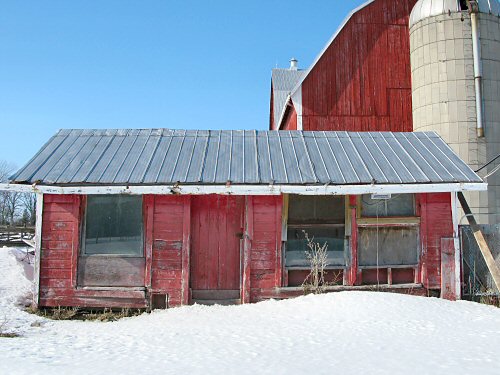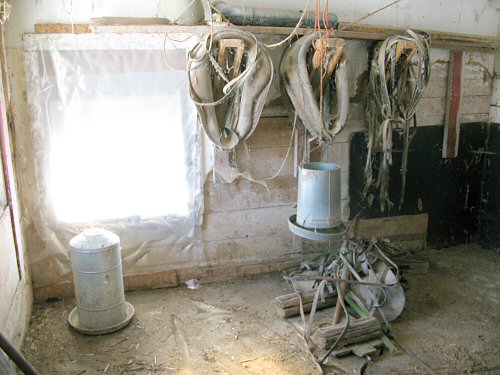
Checked out the chickenhouse today to make up a materials list for the renovation. Here’s a view of the south-facing side (the usual daily view is from the barnyard to the east; the barn and silo are to the north, and hidden behind them is the market garden). From this side, it has that ramshackle cabin-in-the-woods look. I quite like it: 200 sq. ft. of open-plan living, big windows for lots of natural light, electricity, running water…instant home! Like most things on the farm, it has its history. The structure is 80-90 years old, purchased 50 years ago from the farm that used to be across the road (now a village subdivision with a bunch of houses, and untended fields), dragged over by tractor, and set on a concrete pad. It was used as a pony barn for a while; harnesses are still hanging on the wall. For the last 15-20 years, it’s housed a few chickens and turkeys, or been unused. Now, it’s back! There’s not much to do, besides a good cleaning: banging in a defensive baseboard (in the pic below, that’s a GNAWED not-so-little hole under the window), a window to fix, nests to build for the layers, and a coat of lime to disinfect and whitewash (that’ll be interesting). Outside, T-bars and chicken wire to fence in yards, and that should be it. Most of the materials we can salvage on-farm: the fencing stuff, lime, and plywood should be all that requires cash! There are even a bunch of feeders lying around. All these bits from the past, unused and still in place after years and decades, would be a little creepy, if we weren’t coming across them on the way to getting new things started!





that is a great looking chicken house ….looks like lots of potential….
will you be getting “ready to lay ” pullets or will you raise egg layer chicks
Here’s a suggestion based on my experience with the 35 layers that we got last year. We did something similar where we turned a shed into a house. When you are making the fenced in area outside, divide it into three areas so that they can be rotated around. This(in theory) will prevent them from killing the grass and they will always have new grass to eat which will keep them happy and you won’t just have a big mud pit. We are in the process of renovating our chicken area to do this.
Those horse harnesses have quite an antique value. You can clean them up and use them yourself if you plan to use horses around the farm, or you can do some research and sell them. You might be able to purchase the necessary supplies to refurbish the coop if you do that! Good luck!
That is a great chicken house! Can’t wait to see it all full of hens.
I second NS, from above–if you can, make multiple yards that you can let the chickens access in rotation. That way at least one area remains unused and can grow back, so the birds have something to eat.
I love the pictures and reading about the barn. It’s wonderful to have buildings on your property that have a history and stories to tell! :)
Mrs K: Yeah, a little backstory is good. And it’s amazing how much old stuff, especially 50yrs+ mechanical gear, can be just dragged out, dusted off, and put back to work! A couple of years ago, we used an old, manual cider press that’s been sitting in the barn literally for decades. The juice ran out through a wooden chute! Not too sanitary-sounding for…today, and a lot of grunt work per gallon, but we just pulled it out, hosed it down, applied a little grease, and off we went…!
ns, Meg: I like that idea. I’ve wanted to try mobile pens as well, where you just move the whole enclosure with coop from one spot to another around a field. For this first run, I think we’re gonna go with Bob’s approach and keep it simple, with nice big yards (one each for layers and meat birds), and give ’em a fair share of weeds and veggie scraps from the garden. There’s quite a big section available outside the chickenhouse, so hopefully single big runs will do OK. But we’ll see!
cathy: To keep things simple, we’re going for 50 White Rock cockerels for meat (April), and 25 ready-to-lay Shaver Red Sex-Link (June)… It seems like a pretty standard choice. No-one I’ve talked to so far recommends any of the dual-purpose for meat…
UPDATE: We’ve scratched the White Rock Cornish X in favor of a heavy dual purpose cross. The White Rocks seem way too engineered and specialized, I’d rather more naturally-behaving, hardy, roaming, hunting and pecking chickens…which it seems the White Rocks are not…